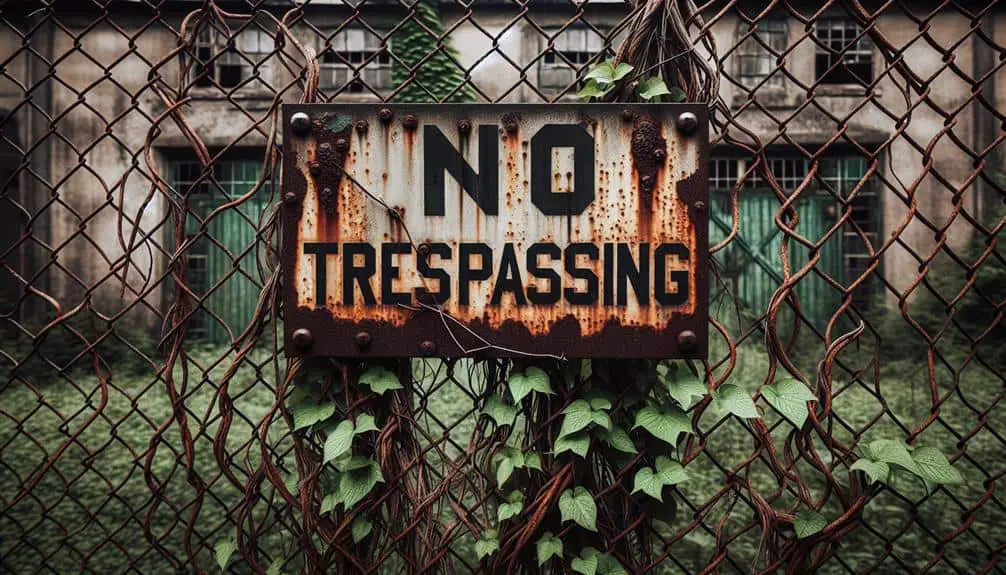When visiting abandoned military camps, prioritize safety by selecting easily reachable yet isolated locations. Consider the site's historical significance and potential safety hazards. Conduct a thorough risk assessment before your visit and equip yourself with safety gear. Research the site's background, architectural layout, and preservation efforts. Prepare a detailed emergency contact list and share your itinerary with a trusted person. Maintain respect for the space by avoiding vandalism and preserving historical integrity. Pack essential items for exploration. Understand local regulations and photography tips for a memorable experience. More insights await to enhance your exploration journey.
Key Points
- Prioritize safety by assessing historical significance, unique features, and safety hazards.
- Carry appropriate safety gear like durable footwear, flashlight, helmet, and first aid kit.
- Research the site's historical background, significance, and wartime importance.
- Prepare emergency contacts, share itinerary, and understand exploration boundaries.
- Maintain respect for the space, follow ethical exploration practices, and report any vandalism.
Choosing the Right Location
When selecting the ideal location for exploring abandoned military camps, consider the importance, historical significance, and safety of the site. Location selection is vital as it sets the tone for your entire exploration. Look for sites that are easily reachable yet maintain a sense of isolation to enhance the adventure. Assess the historical significance of the camp; sites with rich stories and unique features can make for a more fulfilling experience. Additionally, prioritize safety by studying the terrain, checking for any potential hazards, and being aware of the exploration boundaries.
Exploration boundaries establish the limits within which you can safely navigate the abandoned military camp. Be mindful of any restricted areas or dangerous zones that could pose risks to your well-being. Understanding these boundaries not only guarantees your safety but also helps you respect the historical site and preserve its integrity. By staying within the exploration boundaries, you can fully immerse yourself in the experience without compromising your freedom or safety. Choose your location wisely, considering all these factors to make the most of your exploration.
Safety First: Precautions to Take
Prior to starting your visit to deserted military camps, it's vital to carry out a comprehensive risk assessment to identify potential hazards.
Make certain you have the appropriate safety gear such as durable footwear, gloves, and a flashlight to navigate safely through the premises.
Moreover, ensure to have emergency contacts readily available in case of unforeseen circumstances.
Risk Assessment Guidelines
To guarantee your safety when venturing into deserted military camps, it's essential to carefully assess the potential risks and take necessary precautions.
Before setting out on your journey, conduct a thorough risk evaluation by researching the history of the camp, understanding the structural integrity of the buildings, and identifying any potential hazards like unstable floors or debris.
Utilize proper exploration techniques such as moving cautiously, avoiding restricted areas, and being mindful of your surroundings at all times.
Incorporate safety measures into your adventure planning by informing someone of your whereabouts, carrying a first aid kit, and ensuring you have ample lighting.
Safety Gear Essentials
Evaluating the risks when exploring deserted military bases is essential; equip yourself with safety gear essentials to guarantee a secure and successful expedition. Prioritize your safety with these must-have items:
- Flashlight: Illuminate dark corners and navigate through dimly lit areas.
- First Aid Kit: Be prepared for minor injuries and accidents.
- Helmet: Protect your head in case of falling debris or low ceilings.
- Safety Goggles: Shield your eyes from dust, debris, and potential hazards.
- Two-Way Radio: Ensure seamless communication with your exploration team for coordination and emergencies.
Regular gear maintenance is crucial to ensure everything functions correctly when needed, while emergency communication tools like two-way radios can be a lifesaver in critical situations. Stay vigilant and well-prepared during your adventure.
Emergency Contact Preparation
Make sure to carefully prepare your emergency contacts to guarantee swift assistance in case of unexpected events during your exploration of abandoned military camps. Before setting out on your adventure, create a detailed contact list that includes local emergency services, park rangers, and trusted individuals who can assist you in times of need. Familiarize yourself with the emergency procedures of the area you plan to visit, such as the nearest hospitals and emergency exits.
Confirm your contacts are easily accessible, whether in your phone or written down on a physical copy. Remember to share your itinerary and expected return time with someone reliable. Being proactive in organizing your emergency contacts can make a significant difference in ensuring your safety while exploring abandoned military camps.
Researching the History of the Site
When preparing to explore abandoned military camps, begin by delving into the historical background of the site. Understanding the significance of the location will enhance your visit and provide context to your exploration.
Investigating the contextual relevance of the camp will enrich your experience and deepen your appreciation for its historical value.
Historical Background Exploration
Exploring the historical background of an abandoned military camp can reveal intriguing insights into its past and provide context for its significance within the broader historical narrative. Delving into the history of these sites allows you to appreciate their role in shaping the events of the past.
Here are some key aspects to ponder when researching the history of an abandoned military camp:
- Uncovering the strategic importance of the camp during wartime.
- Understanding the daily life of soldiers stationed at the camp.
- Investigating any notable events or battles that took place on the site.
- Examining the architectural layout and design of the camp.
- Discovering the impact of the camp on the local community and surrounding areas.
Site Significance Understanding
To truly understand the significance of an abandoned military camp, explore the historical research of the site to uncover layers of its past and contextualize its importance within the broader narrative of military history.
Investigating the historical background can reveal the cultural significance of the camp, shedding light on its role in shaping local heritage and national identity. Understanding the site's history is essential for site preservation efforts, ensuring that the stories and memories embedded within its grounds aren't lost to time.
Contextual Relevance Investigation
Conduct in-depth historical research to reveal the intricate layers of the abandoned military camp's past, shedding light on its contextual relevance within military history and local heritage. Understanding the history behind these sites not only enriches your urban exploration experience but also contributes to historical preservation efforts.
Here are some essential steps to investigate the history of the abandoned military camp:
- Review archival documents and military records to uncover significant events.
- Interview local historians or residents who may have valuable insights.
- Explore nearby museums or historical societies for additional context.
- Study maps and blueprints to understand the camp's layout and strategic importance.
- Analyze photographs or aerial images to visualize the camp's evolution over time.
Packing Essentials for Exploration
When preparing to explore abandoned military camps, make sure to pack essential items to ensure your exploration is safe and successful. Prioritize survival skills and navigation techniques to navigate the terrain effectively. Pack a first aid kit with basic medical supplies, a multi-tool for various needs, and extra food and water in case of emergencies. Ensure you have a map of the area and a compass to aid in navigation, as GPS signals may not always be reliable in abandoned locations.
Carry a flashlight with extra batteries to explore dimly lit areas and underground bunkers safely. It's also advisable to have a whistle to signal for help if needed. Wear sturdy footwear and comfortable clothing suitable for the weather conditions. Additionally, pack a camera to document your exploration and a backpack to carry all your essentials hands-free.
Respect for the Abandoned Space
Respecting the abandoned space is crucial to preserving its historical significance and maintaining safety during your exploration. When venturing into abandoned military camps, practicing proper exploration etiquette and contributing to preservation efforts not only guarantees a positive experience for yourself but also helps protect these sites for future visitors.
- Leave No Trace: Take only photographs, leave only footprints. Avoid touching or moving any artifacts or structures within the site.
- Respect Wildlife: Remember that abandoned spaces can become habitats for various forms of wildlife. Keep your distance and observe from afar.
- Mind Your Noise Level: Maintain a quiet atmosphere to respect the peacefulness of the abandoned camp and avoid disturbing any potential wildlife or other visitors.
- Stay on Designated Paths: Stick to established trails to prevent unintentional damage to fragile structures or natural features.
- Report Any Vandalism: If you come across any signs of vandalism or illegal activity, report it to the appropriate authorities to help preserve the integrity of the site.
Understanding Local Regulations
Understanding the local regulations is essential before embarking on your exploration of abandoned military camps to guarantee compliance with legal requirements and to promote responsible visitation. Local ordinances play a significant role in dictating what activities are permissible within these spaces. Some areas may have specific restrictions regarding entry times, the use of certain equipment, or even the presence of visitors altogether. Familiarizing yourself with these regulations can help you avoid fines or legal issues during your visit.
Moreover, safety measures outlined in local regulations are designed to safeguard your well-being while exploring abandoned military camps. These measures could include guidelines on wearing appropriate footwear, carrying first aid kits, or informing authorities of your visit beforehand. By adhering to these safety protocols, you not only protect yourself but also contribute to the preservation of these historic sites for future generations to enjoy.
Capturing the Experience: Photography Tips
To enhance your exploration of abandoned military camps, incorporating photography tips can elevate your experience and provide a visual record of your journey. When capturing the essence of these historical sites, consider the following:
- Lighting techniques: Utilize natural light to create dramatic shadows and highlights, enhancing the mood of your photographs.
- Composition tips: Frame your shots thoughtfully, incorporating elements of the environment to add depth and context to your images.
- Equipment choices: Opt for a versatile lens that allows you to capture both wide-angle shots of expansive landscapes and detailed close-ups of interesting artifacts.
- Editing skills: Experiment with post-processing techniques to enhance the colors and textures of your photos, bringing out the unique character of the military camp.
- Attention to detail: Focus on capturing the small, often overlooked details that tell a story and evoke a sense of the camp's history.
Frequently Asked Questions
How Can I Tell if a Military Camp Is Abandoned or Still in Use?
To identify if a military camp is abandoned or active, look for signs like overgrown vegetation, broken windows, and lack of maintenance. Always prioritize safety by staying cautious, avoiding restricted areas, and being aware of potential hazards.
Are There Any Specific Dangers or Hazards to Be Aware of When Exploring Abandoned Military Camps?
In your explorations, remember to prioritize safety precautions. Watch out for hazards like unstable structures or leftover ammunition. While uncovering the historical significance, respect preservation efforts. Stay curious, but stay safe.
Is It Legal to Take Artifacts or Souvenirs From Abandoned Military Camps?
Taking artifacts or souvenirs from abandoned military camps is illegal and goes against preservation ethics. These sites hold historical significance and should be respected. Leave items in place for others to appreciate and for the site's integrity.
How Can I Find Out if There Are Any Paranormal Activities Reported at the Abandoned Military Camp I Want to Visit?
Curiosity beckons, stirring your senses to explore paranormal truths. Unravel the mystery of ghostly lore at the abandoned military camp. Investigate historical significance, haunted rumors, and reported ghost sightings through paranormal investigations.
Are There Any Restrictions on the Use of Drones or Other Technology for Photography at Abandoned Military Camps?
When exploring abandoned military camps, drone regulations may vary. Be aware of technology restrictions and photography rules. Check for any equipment guidelines beforehand to guarantee a smooth and unrestricted experience capturing the site's essence.



